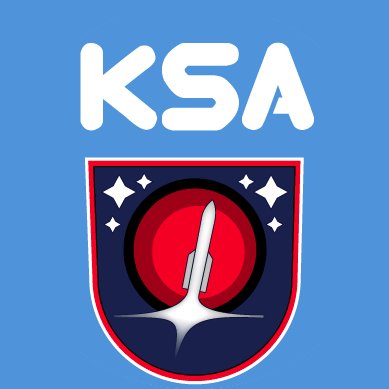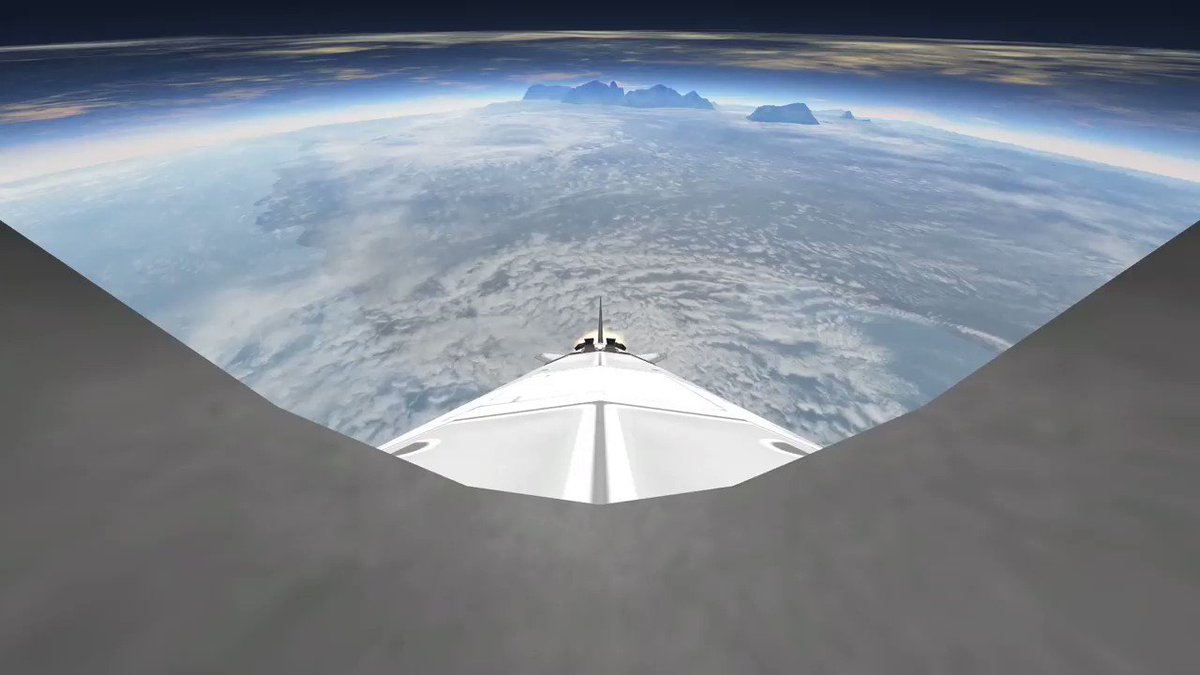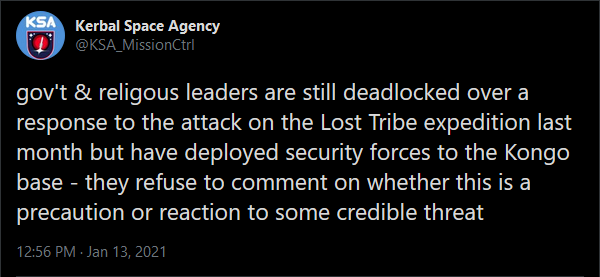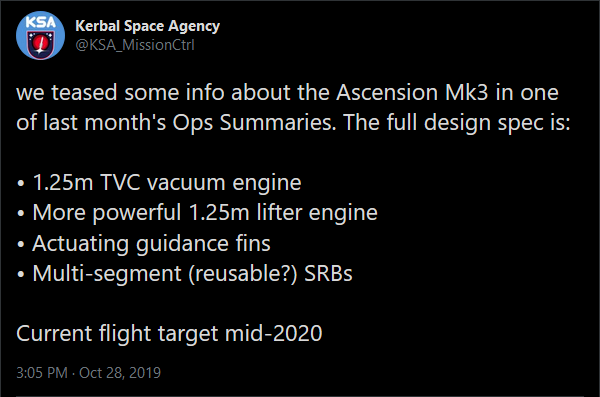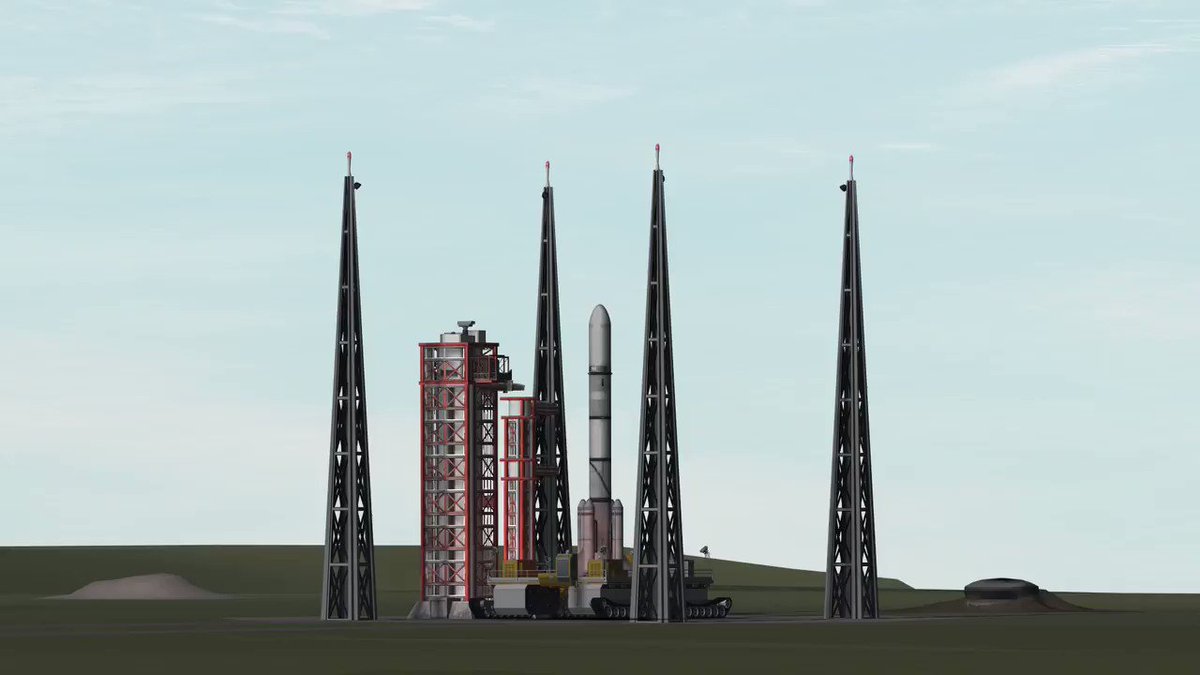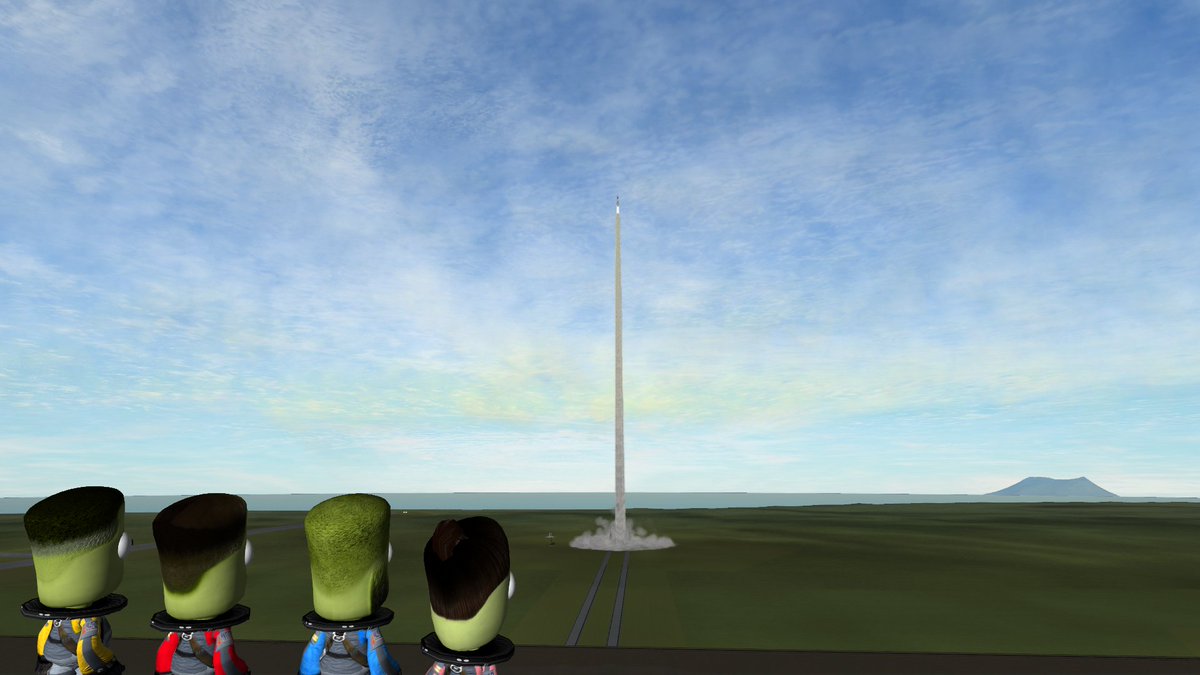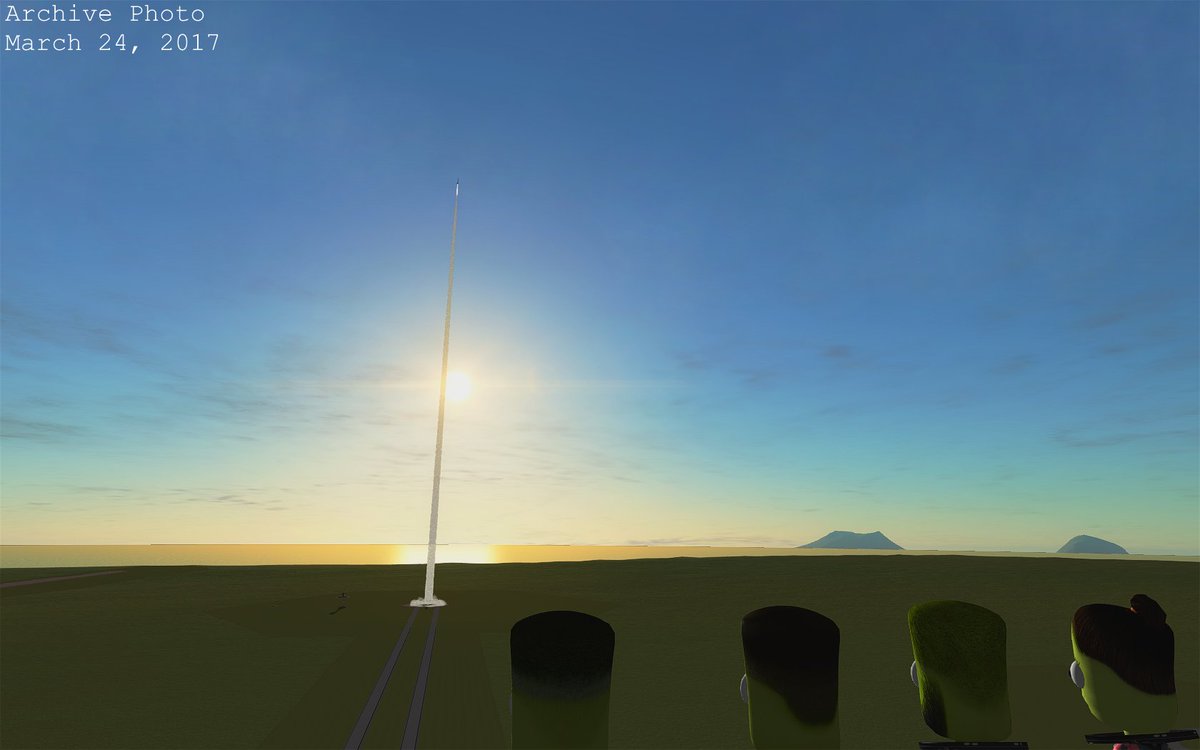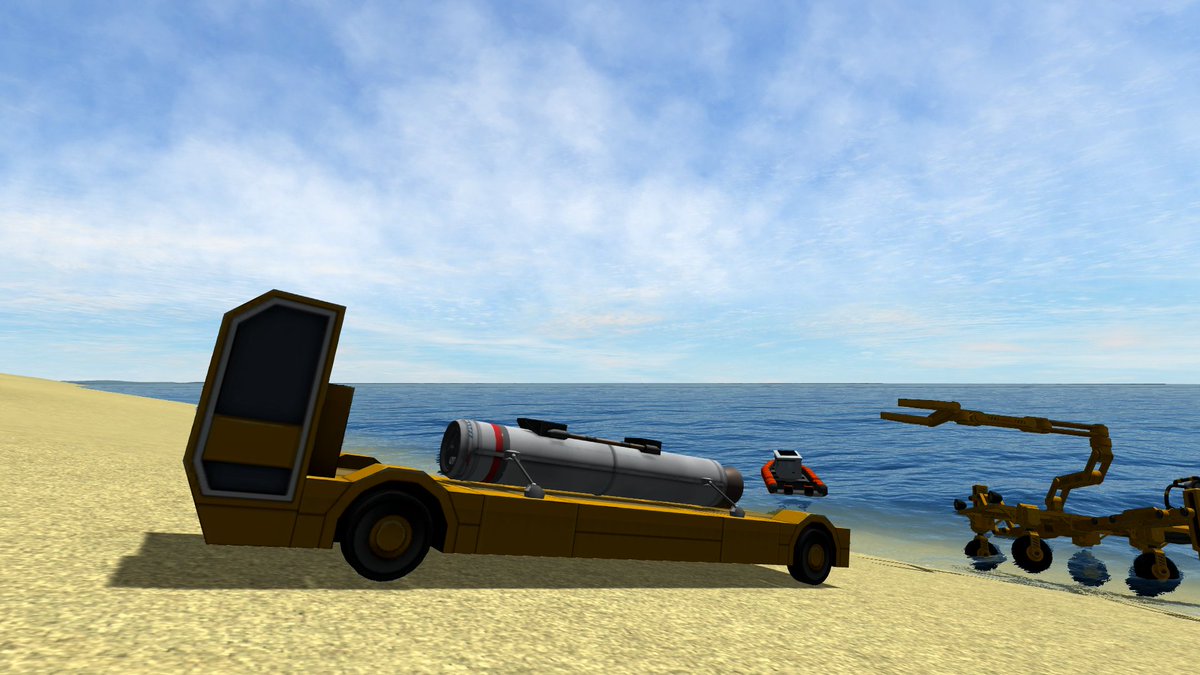|
Ascension Program’s Pivot Towards Kerbed Flight Sees Success on First Mission
This week saw the first launch of an Ascension Mk1 rocket in 2019. The third launch in total, this was also the first flight towards a new mission goal to put kerbals into space on sub-orbital flights rather than attempt to achieve orbit with probes. Well, as a first priority anyways. Ascension was always meant to carry astronauts into space eventually but it was planned to happen later this year rather than sooner. This week’s launch was an important step in allowing us to test new technologies that will be essential in allowing kerbals to operate in space and return safely. The reaction control system, comprised of 10 cold gas thrusters spaced around the payload test weight to control roll, pitch and yaw, had some minor issues at the start but otherwise performed as designed to properly orient the payload along various vectors relative to the trajectory. The heat shield, made of an ablative material to burn away during re-entry and keep the payload relativity cool, survived landing intact thanks to the low-mounted radial chutes flipping the payload over to land nose-first as planned.
Most notably on this mission however was our use of the Launch Vehicle Designer, a recent addition to the KSP Trajectory Optimization Tool. Everyone on the Ascension team is eager to compare the actual telemetry data with the projected data that can be exported from the LVD. We already know from the way the launch turned out the rocket was unable to meet the ascent profile it was programmed for, but seeing how the data deviates can still be very useful in helping the developer to improve the software and us to plan future launches.
Full details on the RCS, heat shield and LVD usage will come with the flight analysis, expected sometime in early February. This will also as always include information on where the Ascension program will go for its next mission.
Dhumla Takes First Steps Towards Flight
This week the Dhumla completed an assembly process that has taken over half a year, although this was in part due to the latest Monolith incident. It was finally rolled out of the HAB today and underwent the first two ground trials that will lead to flight hopefully before the end of the month. The first trial consisted of merely ensuring all the engines were assembled into the aircraft properly (they were tested individually prior to installation) and could be controlled properly from the cockpit. During this time data was gathered on engine status such as fuel flow, thrust output, manifold pressure, RPM, exhaust temperature, and hundreds of more parameters. After review of the data the aircraft was cleared for its second trial later in the day which consisted of the crew learning how best to handle it on the ground, taxiing around. Another data review is scheduled for Monday ahead of a third trial that would take the aircraft just short of the point of flight.
In additional news from the Genesis program, the Deuce flew a science mission that once again blew away a number of previous records. The aircraft still has yet to turn a profit after its long and costly development but these long-haul missions are what it was built for and the continued success should start to bring more interest and thus contract opportunities.
Progenitor Moves Forward with Next Mk6-I Launch
This week the flight analysis for last week’s mission was published. We can still only speculate on why the payload could not be recovered but the investigation could find no reason to postpone or alter the follow-up mission that would carry additional material samples into space. The launch has been scheduled for 2/7 @ 17:11 UTC.
ATN Database
The latest update for the Asteroid Tracking Network database is available here, containing 3,068 asteroids and 1 updated with new observation data.
From the Desk of Drew Kerman
Out of Character Behind the Scenes stuffWritten on 12/10/18
Ooof, first deficit in a while, taking 9 real days to do 7 KSA days. That’s not good but like I said this 3 launches in 3 weeks deal isn’t how I plan to do things for the rest of the year so just gotta push through, get out of January and start pacing things out again.
Ascension mission
So yea it was only because I’m so far ahead in lead time I was able to completely redo the mission design and no longer attempt for orbit while also going back to tweets I wrote in December and changing things so that there would have been a reasonable amount of time to redesign the mission. Without lead time had I been doing this in January I would have just been forced to proceed as planned and go for another orbit knowing it would fail but having to write as if I thought it would succeed. I’m glad I didn’t have to waste time doing that. Yay lead time!
That said, the redesign led to a lot of work, because now I had to build a new payload and also match that mass to what the capsule would be so I had to essentially also plan out what my ideal capsule mission would be like so I could replicate that with the NRAP test weight. This meant learning the ins and outs of the Kerbalism life support and mission planning system, making sure everything was compatible and working properly. Furthermore I needed to create my own thruster parts out of the ones that came with the MandatoryRCS pack, using the cold gas resource defined by Archtagon Aerospace.
A lot of work also went into the ascent profile using the LVD, not only did I have to work out a good profile but I had to figure out how to use the LVD – thankfully it was mostly built upon Mission Architect and after stumbling over a bit of understanding with how it processed events differently I got the hang of it pretty quick. But the properties I wanted to optimize, hitting a certain pitch by a certain altitude, were not able to be optimized by the program itself yet (it can now in the latest release) so I had to do a lot of fiddling with values manually.
Oh geez and then I spent a good 2hrs hunting down RCS issues including an issue with the test weight not giving me access to the full SAS capabilities. Turns out even though you can use a tweakable slider in the VAB to set the SAS Level to 3, whatever is defined in the part config file is as high as it’ll go and there was no defined value for the test weight (which originally came out before SAS levels were introduced to the game). The other problem was with RCS enabled the kOS steering manager was unable to actually point the payload in the proper direction – it would keep missing the hold point and oscillating back and forth wildly. I thought my thrusters were just too badly placed or too low-powered. Turns out it was the fact that the test weight has a ridiculous amount of reaction wheel torque that was wildly-overcompensating for movements despite having MandatoryRCS installed (but not compiled for KSP v1.5.1 so I guess wasn’t working properly). When I completely disabled all torque wheels the kOS code was able to point properly.
Getting ready to write the launch for the Wednesday I remembered – “hey dummy this is a day you actually have to do work IRL” which sucks because I would definitely want to be at my computer during this launch. So it was delayed to Thursday, tho I think I may have delayed it anyways because I liked the technical issue that I came up with of having more empty area in the tank to pressurize.
It took me 6 tries to do everything properly – as usual syntax and logic errors were the main culprits and I need to work out a better and faster way of run-checking my code before I waste time setting up for a launch and going through with a mission and spending like 40min total to have the payload returning and the program crash because I didn’t check to make sure the variable I defined for the parachutes was the variable I used to reference the parachutes. ARGH! So yea it basically took an entire day just to run the mission properly. One logic error did provide for some interesting storytelling in the RCS not cutting out after 10s. I’ll explain the in-universe reason for that happening in the flight analysis. The computer crash at the end of the flight also really happened, on the sixth attempt, and at that point I was just like – “fuck it”.
Also every time I reset to the VAB all the surface attached parts on the test weight sunk to the middle and had to be replaced. -_-
Of course those six attempts were merely to fly the actual mission. I then had to design two variants of the rocket because I couldn’t stand how it actually looked with the heat shield shroud. Ugh. Peh. Yick. So I made a second one that had the heat shield clipped into the decoupler. This is the one seen in all the launch and prelaunch photos. But clipping the heat shield like this meant that when the decoupler fired, even with a force of 0 the capsule was thrown away violently and I wanted to have it push gently away with the RCS system. So a third rocket was built with the heat shield close to but not clipping into the decoupler. I then edited this rocket into the save file my kOS code created as soon as the actual rocket entered space and that’s what was used to film the separation. So yea I didn’t refly the whole ascent but still got to capture what the actual rocket would have seen. In the future, since I’ll need to do this with the capsule too, I’ll just edit the attachment node lower.
Oh but the work wasn’t over yet! In addition to doing all my other post launch work (flight database, website mission post, writing the tweets, cleaning up the kOS log, taking photos, etc etc) I had to massage the telemetry data because I only realized after this launch that I had forgot to patch in EC consumption for the radio antenna when adding RemoteTech support to the test weight. So I had to go back and edit the telemetry data of the two previous launches as well. There’s more but I’m looking back up at this giant wall of text and I think you all get the picture.
I’m actually pretty happy this week of operations only took 9 real days considering everything that happened!!!!!
Deuce mission
The main purpose of this flight was to stress-test KSP v1.5.1 and it came through wonderfully. I fly aircraft missions in real time so that was a solid 4.5 hours of actual time spent on that first leg to the Badlands and up to Ockr. Not a single issue, game ran smooth as butter the whole time. Sweet! Thankfully I can use FAR‘s flight assistance to hold wings level and even slightly banked to follow a great circle path and now AFBW has very fine trim controls so staying level is way easier. Even though I still don’t use a full autopilot I was mostly able to fly the mission while catching up on my magazine reading on my iPad.
Dhumla testing
So yea, first off I will admit the propeller placement is really really close to the ground, but I was able to raise them up a bit without breaking through the top of the wings and deviating more obviously from already-published images.
Good lord I still hate KSP wheel physics with a passion. Look at this shit. That’s after adding fuel all at once with TAC Fuel Balancer. I’m not doing anything with any controls its just oscillating on its own. This is with the spring/damper settings on automatic, no less. I don’t even. Stiffening things up made it better and I can actually taxi this aircraft around without it thinking its a low-rider with a hydraulic suspension.
The turnabout technique is totally a real thing and I was actually working it out during the testing. Best result was to slow to 1m/s, turn the wheel all the way over, and engage reverse thrust (I have buttons on my X55 throttle for this). Throttle up to ~15% and then halfway through the turn cut throttle to idle. 3/4 of the way through the turn toggle off reverse thrust and then steer out with the nose wheel back to straight. I actually don’t need to use reverse thrust to turn the Deuce, it is small enough to swing around at the end of runways just with normal steering.
The engines I’m using are from KAX, and the sounds for them are… pretty sucky to be honest. So I dug into the Airplane Plus folder and checked out the sounds it used for the Hercules engines. Much better! I used the actual startup and running sounds for the herc engines that come with that pack but also added in another engine’s startup sound for a bit more cough and rumble.
Finally, I got around to installing the newer aviation lights into all my aircraft (they were using the original models by BigNose). Busy week and a half, indeed!!








